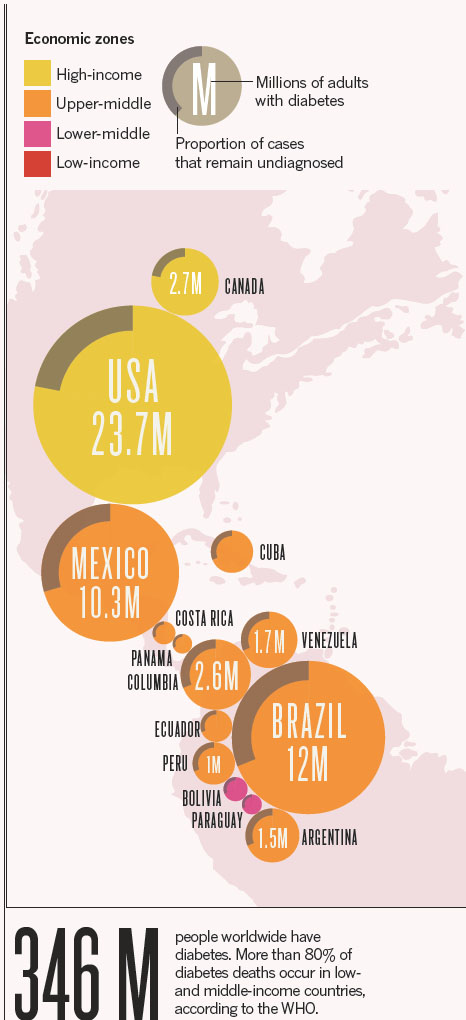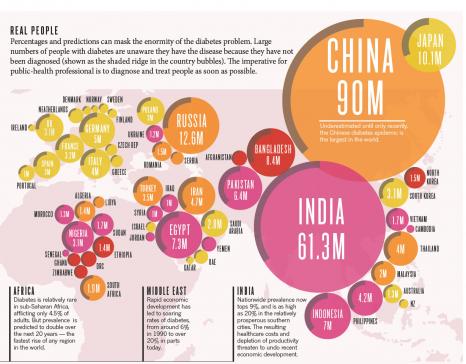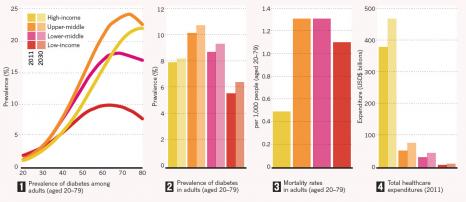Lately there has been a flurry of media reports focusing on America's obesity epidemic, and how costs associated with America's gradual shift to a fat society will inundate the already strapped budget in the form of shadow taxation and other direct and indirect costs, which are, to put it simply, unsustainable. As the first chart below shows, the primary cost center associated with the obese conditions - diabetes - has certainly gripped a substantial portion of the US population, at last count affecting at least 10% of the population.
Yet as chart #2 shows, America, with its $23.7 million diabetes cases, actually has it good. Because when compared to countries without a social safety net, such as China and India, the US diabetes problem is child's play. With 90 million diabetes cases in China, and 61.3 million in India, or nearly half of the total 346 million worldwide diabetes cases, perhaps it is time for the developing world to worry how they plan on funding the billions of associated costs, as they assimilate more and more of the worst American habits. Because as the International Diabetes Foundation says, "In developing countries, the looming costs in human lives, healthcare expenditure and lost productivity threatens to undo recent economic gains." However since all of this is in "the future" what's the point of worrying about it now...
American diabetes is bad...
...But not nearly as bad as what is happening in the "developing" world. Whoops:
Finally, from the International Diabetes Foundation, here are the facts:
Th e number of people living with, and dying of, diabetes across the world is shocking: 90 million Chinese live with diabetes and 1.3 million died in 2011;23% of Qatari adults have developed diabetes.
Tsunami Of Diabetes
- Type 2 diabetes accounts for almost 90% of all cases of diabetes in adults worldwide. In general, as countries become richer, people eat a more sugar- and fat-rich diet and are less physical active - and the incidence of diabetes rises. On average, nearly 8% of adults living in high-income countries (see map for country classi fication) have diabetes. It is, however, upper-middle and middle-income countries that have the highest prevalence of diabetes; over 10% of adults in these countries have the condition.
- In high-income countries, diabetes primarily affl icts people over 50 years of age. But in middle-income countries, the highest prevalence is in younger people - the most productive age groups. As these people age, and as life expectancies increase, prevalence in older age groups will rise further. This trend will put a huge burden on healthcare systems and governments.
- Th e mortality rate of diabetes varies sharply with the prosperity of the country. In 2011, the disease caused more than 3.5 million deaths in middle-income countries, of which more than 1 million were in China and just less than a million were in India. Approximately 1.2 adults die of a diabetes-associated illness per 1,000 cases in 2011 in low- and middle-income countries: more than double the mortality rate of high-income countries. Mortality rates are much lower in high-income countries with the greater healthcare recourses, but those tolls are still high: approximately 180,000 people died in the United States in 2011, for example.
- Unsurprisingly, high-income countries spent vastly more on diabetes-related costs in 2011 than lower-income countries. In developing countries, the looming costs in human lives, healthcare expenditure and lost productivity threatens to undo recent economic gains.







Reader Comments
to our Newsletter